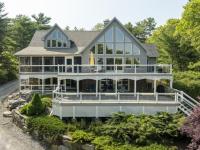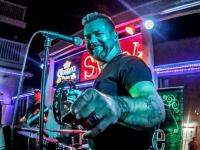Warm Southern Memories
The first time we saw a yellow-throated warbler was during a spring break from Cornell University during our grad school days. We drove south from the cool, early spring weather of Upstate New York headed to the Outer Banks of North Carolina. Somewhere in southern Pennsylvania the highway led into a tunnel burrowed through the base of a mountain. When we came out on the other side it seemed we had passed from north to south. The temperature was warmer, flowers were in bloom and, soon enough, we expected to start seeing more birds. By the time we got into Delaware and Maryland our wishes were fulfilled as flocks of boat-tailed grackles raucously called from the roadside; we began to spot black vultures among the more common turkey vultures.
But it was at a stop at a boat ramp along a waterway in Virginia that we got our first view of a bird that typified the south for us, a yellow-throated warbler. The way we remember it, the bird was creeping and flitting at the top of a tall trees draped with Spanish moss, occasionally singing its sweet song, oblivious to the two people standing below soaking in views through binoculars of its bright yellow throat.
Since then we’ve seen yellow-throated warblers in many other places—Florida, Missouri, New Jersey, New York, North Carolina, even the Dominican Republic where they winter! The northeastern edge of the breeding range for the species is generally in Pennsylvania and New Jersey, though a few make it up into New York State in some years. Eastern populations winter from central Florida south into the Greater Antilles.
So it was a great surprise to hear through the birding listserve a week or so ago that a yellow-throated warbler was coming to a feeder just down the road in Bowdoin. Every year, a few yellow-throated warblers show up north of where they should be, even in early winter. Presumably the lucky and smart ones that get too far north find feeding stations where they can acquire enough food to survive and so most years there are a few of these wintering birds reported across the U.S. north of their normal wintering range.
There are theories for why a southern bird like a yellow-throated warbler might appear north of where it should be. Maybe it was a bird, fooled by the unseasonably warm conditions on its wintering range, starting its spring migration a few months too early and it just didn’t stop when it should of. Maybe it was a bird whose “brain wires were crossed” by some abnormality so that it confused north with south. Or maybe there are always a few individuals with any population that push the edges of what everyone else considers normal and, if conditions change, end up being the successful pioneers of a new normal.
Either way, we were very interested in seeing an out-of-range yellow-throated warbler so a few days ago, off we went. We waited on a frigidly cold day with other birders in the yard of the wonderful birder naturalists who found the bird at their feeders and have graciously welcomed interested birders. It didn’t take long before this bright-yellow-throated bird, looking a bit out of place among the black and whites of chickadees and woodpeckers, appeared and gave us fabulous views through the binoculars and telescope as it foraged under the suet feeder and then flew up to huddle on an old phoebe nest under the eaves of a neighbor’s roof. It was a setting strikingly different from the Spanish moss draped trees where we watched our first one on that warm spring in Virginia, but every bit as memorable.
Jeffrey V. Wells, Ph.D., is a Fellow of the Cornell Lab of Ornithology. Dr. Wells is one of the nation's leading bird experts and conservation biologists and author of the Birder’s Conservation Handbook. His grandfather, the late John Chase, was a columnist for the Boothbay Register for many years. Allison Childs Wells, formerly of the Cornell Lab of Ornithology, is a senior director at the Natural Resources Council of Maine, a nonprofit membership organization. Both are widely published natural history writers and are the authors of the book, Maine’s Favorite Birds.
Event Date
Address
United States





























